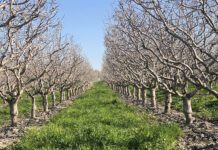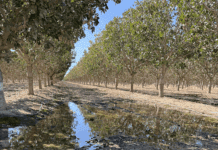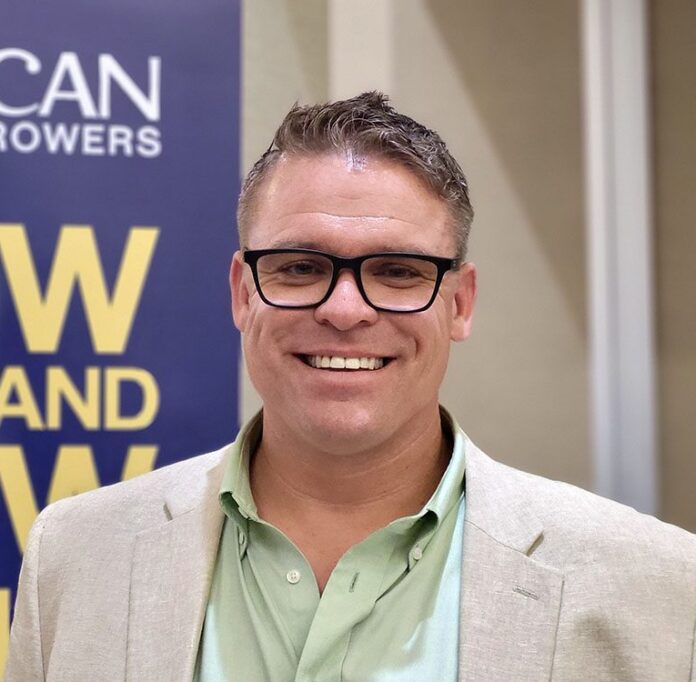
For now, Zachary Fraser may know more about college sports than he does about the pistachio industry.
But that’s changing as he plunges headfirst into his new role as president and CEO of American Pistachio Growers. Since taking the reins June 17, Fraser has been learning all he can about the pistachio industry and the 865-member trade organization he’s tasked with leading.
Fraser, 45, comes to APG after four years with LEARFIELD, the media and technology company behind many of the most influential brands in collegiate sports. There, he led the company’s Fresno State athletics property, helping manage traditional and digital media rights, broadcast platforms and media and sponsorship sales for the Fresno State Bulldogs.
Before that, Fraser was the founding general manager and managing partner of Pacific Baseball Ventures, an investment group which owns and operates summer collegiate teams in Washington State. Under his stewardship, more than 30 players went on to play Major League Baseball.
Just two weeks after starting his new job at APG’s Fresno office, Fraser spoke with West Coast Nut about his plans for APG and how he’ll apply what he knows about building a sports fan base into “supercharging” a global passion for pistachios.
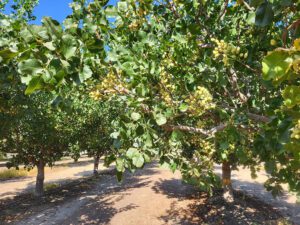
Q. Why did you decide to pursue the position of APG’s president and CEO?
I wanted to be excited about what I was doing every single day. I’ve been blessed to have a great career in sports media and sports marketing. When I started out 20 years ago, that was a passion. And I still care about it. But it wasn’t something that got me really juiced and pumped up to get out of bed every morning. As I started to have conversations with members of APG and some of their leadership, I became more and more excited about what I saw as an opportunity to really supercharge a product and to find ways nobody’s ever thought of to get our pistachios into the hands and diets of 8 billion human beings around the earth.
Q. Did a recruiting firm find you? How did you and APG connect?
APG had done some work with my company over the last two or three years here locally with Fresno State Athletics. If you’re from the Central Valley, you know it’s a small town. If you make a lot of connections, but also if you’re good at what you do, and you work hard, and you’re transparent and honest with people, that gives you an opportunity to stand out. It’s kind of fun being a guy who just popped on the scene and who’s being given a chance to be a rookie in asking questions and learning in a way that, if I’d come from the industry, I don’t know that I would be as open to doing.
Q. How can APG benefit from what you learned during your career in collegiate sports media?
The genius of sports, and collegiate sports in particular, is that it’s not transactional. If you are a fan of a sports team, you are enveloped in experiences. For instance, I’m a huge Buffalo Bills fan. I grew up back East and have been a diehard Bills fan since I was eight years old. I have a professional obligation, when I see somebody wearing a Buffalo Bills hat in an airport, to yell across the aisle and say, “Go, Bills!” That’s a fan reaction. That’s not a transaction or a customer reaction. Sports creates fans. They don’t create customers.
We have a remarkable story to tell around pistachios’ nutrition, around the quality of taste, around the farmers who are growing pistachios, around the processors using best-in-class methods to get those into market. We have 8 billion humans that can buy and enjoy our product. How do we create that type of fan reaction, that fan experience for pistachios? That is what can come from sports.
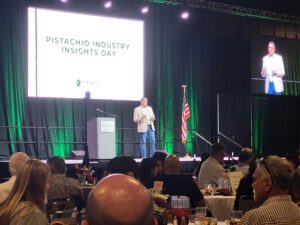
Q. What plans and ideas do you have for APG and the industry? How do you plan to build consumer demand?
My plans are specifically around this idea that every single human on earth can eat and love eating pistachios. The specific key results, the specific tactics, activities and processes that we’re going to use to get there are very much still in the embryonic stage. That’s going to develop over the next 30 to 60 days as I get to know who I’m serving and working with, as I spend a significant amount of time with our VP of marketing, and understand our consumer data reports and other things that help us create a strategy.
Q. What are the first three goals on your list?
The first is for me to be mobile, to be on the road, be in front of people, meeting members face to face. I won’t be able to meet everyone in the first 90 days, but I set a personal key result for myself to meet 100 growers or more by Sept. 30.
The second one is to listen and learn. I don’t come from pistachios. I didn’t grow pistachios. I didn’t go to school here. I wasn’t raised in Future Farmers of America. I don’t have any connection to the industry whatsoever, other than the fact that I really like to eat pistachios. There’s a lot of good that preceded me at APG. What can we pull out and replicate?
There are also some challenges, right? Anytime an industry goes through an explosive growth over a 35-year period, there are growing pains in relationships, in personalities and in processes. Because I was not involved in any of them, you can scream at me for an hour if you want. It’s not going to hurt my feelings. I have the benefit of just smiling and listening. Once we listen and build that relationship of trust, we take that information to see how we can apply that wisdom to not repeating some of the same mistakes.
The third goal involves the team we have onboard. There’s phenomenal talent here. This is the kind of team I would hire if I was building this team from scratch. I’ll be looking to identify with this team, to understand where their strengths and weaknesses are, how I can best position them, how I can best fill in the gaps to really put a supercharged team together so we can hit that objective. I want 8 billion people eating pistachios every day and loving it.
Q. An enormous volume of pistachio production is forecast for the next few years. How do you plan to market that increased supply?
I like to find any way that’s not illegal or immoral! And then be very intentional about our use of resources. I love marketing-planning meetings because that’s where you get to be really creative. When you start to translate what those ideas will cost, it tends to get you in perspective as to what you can actually do. So, let’s go find really crazy ideas, and let’s make sure we can afford them. Those are two important components. Let’s identify the buy-low, sell-high opportunities in terms of developing markets. Where are folks with disposable income? Where are folks that are able to spend money on a great American product?
India is the fastest-growing middle class in the world right now. They like nuts that supply proteins. How do we use our strong base of Indian farmers here in the Central Valley, paired with our great processors? How do we get more pistachios into the Indian market?
Asia is another market with great opportunities. Asia is tough because it’s not really a buy-low market. Media in Asia is fairly expensive, but the upside is the significant number of people we can reach. How do we make inroads there?
The other idea is looking at other industries. Every industry has a tendency to basically do what everybody else is doing and just do it a little bit better. What are great things happening in other verticals that we can bring over and replicate in the pistachio market? Everything is on the table for review. If we’ve been doing something for a long time and we’re not seeing a significant growth or results, let’s stop doing it. Let’s be willing to test the waters with other things that we may not be comfortable with today.
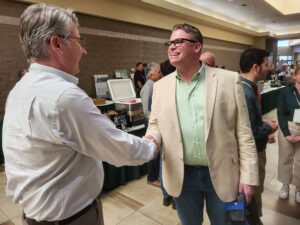
Q. Why should pistachio growers support APG?
Because, by being able to combine forces, we will deliver products that are going to create an exceptional experience for the consumer, and on a scale that’s hard to do for an individual grower or individual processor. Eight billion people is a lot of human beings. The number of dollars needed to reach all the media channels, the influencers and every possible way that we can reach human beings, they’re vast and expensive.
A rising tide lifts all boats. We need everybody who loves pistachios, who’s involved in this industry, to be a member of what’s going on and chip in however they can, whether it’s a membership assessment or a level of expertise or pairing brands together to open markets. We can figure out a way to get everybody working together. Let’s break open the hole for every market that’s out there. We need to push the market through so our growers and processors can move billions of pounds of pistachios over the next five years. Let’s ride this wave together.







